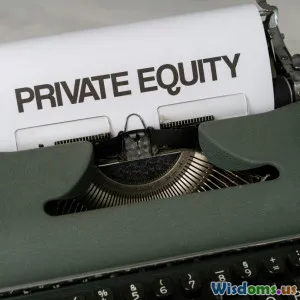
Private Equity vs Public Markets Which Delivers Better Returns
9 min read Explore the comparative returns of private equity and public markets with in-depth analysis, data, and real-world insights to optimize your investment strategy. (0 Reviews)
Private Equity vs Public Markets: Which Delivers Better Returns?
Investing is a complex dance between risk, return, liquidity, and time horizon. Among the countless options available, two giants dominate discussions: private equity and public markets. Each offers distinct advantages, challenges, and insights that influence not only individual portfolios but the broader economy.
But which truly delivers better returns? This question echoes throughout financial firms, family offices, institutional investors, and advisors alike. By diving deeply into historical performances, structural differences, and real-world case studies, this article will unpack the value proposition behind private equity and public markets to help you make an informed decision.
Understanding the Investment Arenas
What is Private Equity?
Private equity (PE) refers to investing directly into private companies or buyouts of public firms resulting in their delisting from public stock exchanges. PE investments tend to be illiquid, long-term, and heavily involved—usually managed by specialized funds and involving active governance and operational improvements.
Key features of private equity include:
- Illiquidity: Typically, investors lock up capital for 7–10 years.
- Active Management: PE firms often implement strategies to boost company performance.
- High Minimum Investments: Access is often limited to accredited investors or institutions.
What are Public Markets?
Public markets involve buying and selling shares of publicly listed companies through stock exchanges like the NYSE and NASDAQ. These markets are characterized by:
- Liquidity: Shares can be bought or sold daily.
- Transparency: Mandated disclosures and regulatory oversight.
- Accessibility: Available to retail and institutional investors alike.
Both realms attract billions of dollars worldwide; hence, the core question is not access but performance and risk.
Historical Return Comparisons
The Performance Debate
One prevailing argument in favor of private equity is superior returns. For instance, according to Bain & Company's 2023 Global Private Equity Report, the median net Internal Rate of Return (IRR) for private equity funds over the past two decades hovered around 13–15%, outperforming the public equity markets' average returns of approximately 8–10% annualized.
Michael Mauboussin, a leading expert in investment strategy, supports this with nuanced caution, acknowledging private equity’s "illiquidity premium," the additional returns investors demand for bearing a longer lock-up period.
However, these numbers deserve context:
- Survivorship Bias: Often only successful PE funds report returns.
- Risk Adjustment: Raw returns alone aren’t sufficient; risk factors must be included.
- Fee Structures: PE funds charge higher fees (management fees plus carried interest), affecting net investor returns.
Academic and Industry Studies
A seminal study by Kapilendo and McKinsey (2021) analyzed over 600 private equity funds and compared them against MSCI World and S&P 500 indices. Their findings:
| Asset Class | Average Net IRR | Volatility (Std Dev) | Liquidity |
|---|---|---|---|
| Private Equity | 14.2% | 10.5% | Low (7–10yr lockup) |
| Public Markets (S&P 500) | 9.8% | 15.2% | High (daily liquidity) |
This tells us private equity's returns come with lower historical volatility but at the cost of extended illiquidity.
Drivers Behind Return Differences
Illiquidity Premium
A major justification for private equity’s premium is illiquidity. Investors demand higher compensation for surrendering access to their capital for a long period.
Example
Consider a venture capital fund investing in early-stage tech startups—capital is tied up for years before any exit opportunities. This illiquidity means investors only get paid with an expected higher return.
Operational Improvements
Unlike passive public market investing, private equity investors often drive operational enhancements, restructuring, and strategic pivots to unlock value.
Case Study: Blackstone’s Acquisition of Hilton
Blackstone acquired Hilton Hotels in 2007 for $26 billion when the company struggled financially. Through active portfolio management, cost efficiency improvements, and strategic repositioning, Blackstone exited in 2018 for roughly $36 billion, delivering an annualized return estimated near 20%.
This level of hands-on involvement is rare in public markets.
Market Inefficiencies
Private equity capitalizes on less-efficient pricing in private companies. Public markets are more efficient due to transparency and competition.
Risks and Challenges
Private Equity Risks
- Illiquidity and Long Lock-up: Ties investors’ capital.
- Blind Pool Risks: Investors commit before investments are made.
- High Fees: Management plus performance fees can erode returns.
- Herding and Overpaying: The influx of PE funds sometimes leads to inflated valuations.
Public Market Risks
- Market Volatility: Daily fluctuations can affect portfolio value.
- Information Overload and Noise: Investor sentiment can lead to irrational pricing.
- Limited Control: Investors can't directly influence company operations.
Liquidity & Accessibility Considerations
Public markets offer transparency and liquidity unmatched by private equity, which is appealing for investors who require flexibility and real-time market pricing.
On the other hand, the longer investment horizon in PE suits those with greater capital commitment and tolerance for illiquid assets, such as pension funds or family offices.
Tax Implications
Certain jurisdictions afford favorable tax treatments for gains realized through private equity investments, such as lower capital gains rates or rollover reliefs, which can augment the after-tax returns comparing to typical public equity investments.
Nonetheless, tax rules are complex and investor-specific.
Real-World Portfolio Impact
Institutional Investors
According to the 2022 Preqin benchmark data, pension funds allocating 10–15% to private equity experienced enhanced portfolio diversification and improved risk-adjusted returns when compared to those fully invested in public markets.
Retail Investors
Accessibility is growing with interval funds and listed private equity vehicles, but barriers remain higher. Conversely, the public markets remain a primary channel for retirement saving plans globally.
Conclusion: Which Delivers Better Returns?
The evidence suggests that private equity, historically, has delivered higher gross returns than public markets, largely due to illiquidity premiums, active management, and market inefficiencies.
However, this comes paired with greater challenges:
- Limited liquidity
- Larger capital commitments
- Higher fees and risks
Public markets offer more accessibility and flexibility, appealing to a broader set of investors.
Final Thought
Investors should balance their goals, risk tolerance, time horizon, and available capital. A blended approach exploiting long-term private equity gains alongside public market liquidity and transparency often provides a compelling path.
Investing in either realm requires careful due diligence, understanding structural differences, and aligning choices with individual or institutional objectives.
References:
- Bain & Company, Global Private Equity Report 2023
- Michael Mauboussin, "The Capitalism’s Illiquidity Premium," CFA Institute
- Kapilendo and McKinsey, "Private Equity Performance 2021 Analysis"
- Preqin, 2022 Global Institutional Investment Data
- Blackstone’s Hilton Transaction Disclosures
Author’s Note: Unlocking better returns involves not only data but understanding nuances and investor context. Proceed wisely!
Rate the Post
User Reviews
Popular Posts

















